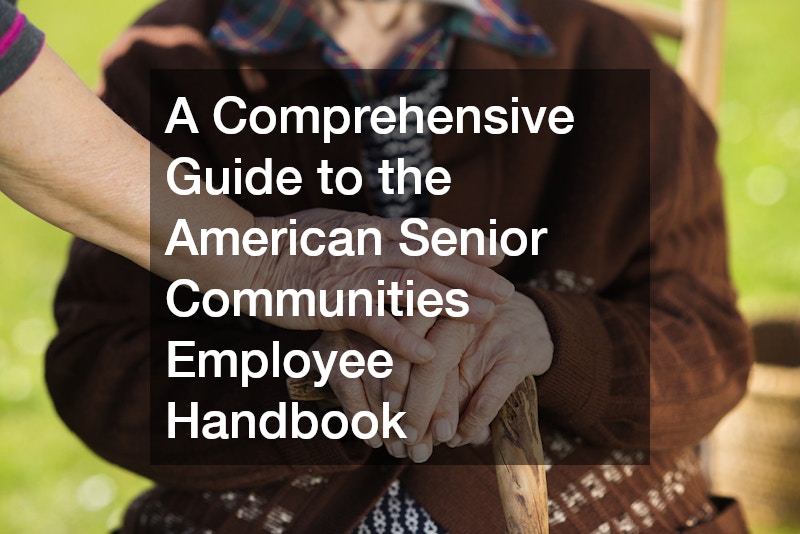
A Comprehensive Guide to the American Senior Communities Employee Handbook
Introduction
The American Senior Communities Employee Handbook serves as an essential guide to help employees understand their roles, responsibilities, and expectations within the senior care environment. Whether employees are working in assisted living communities, senior apartments, or providing home healthcare services, this handbook is designed to provide clarity and consistency in delivering care to the elderly. It outlines key policies and procedures that help ensure the well-being of both staff and residents while promoting a safe and supportive workplace culture. Understanding the content of the employee handbook is critical for fostering high-quality service and supporting the health and comfort of seniors under professional care.
This comprehensive guide will explore the key elements of the American Senior Communities Employee Handbook, focusing on policies that shape employee expectations, promote high-quality service, and prioritize the well-being of residents in various care environments. The following sections will provide insights into staff training, wellness programs, ethical guidelines, and more, ensuring that every aspect of the employee experience is covered to guarantee both employee and resident satisfaction.
Understanding the Key Policies That Shape Employee Expectations in Senior Care Environments

The employee handbook outlines clear guidelines for employee conduct, setting expectations for professional behavior, communication, and collaboration within senior care environments. Employees are expected to maintain a compassionate and respectful attitude towards residents and fellow team members, creating a positive atmosphere in which quality care can thrive.
Policies related to punctuality, dress code, and communication standards help employees establish a professional demeanor in front of residents and their families. These guidelines ensure that each employee is representing the company’s values and providing a high level of care at all times.
The handbook also addresses attendance policies, which are crucial in senior care environments where staffing shortages can directly impact the quality of care provided. Clear attendance and scheduling expectations allow employees to understand the importance of consistency and availability in caregiving roles.
Confidentiality is an essential aspect of senior care, and the employee handbook emphasizes the protection of resident privacy and compliance with HIPAA regulations. Employees are expected to respect the confidentiality of residents’ medical and personal information. The employee handbook also addresses workplace safety, ensuring that all staff members are trained to provide care safely and responsibly. This includes guidelines on ergonomics, infection control, and the proper handling of medical equipment.
Ensuring High-Quality Service Delivery Through Employee Guidelines
The employee handbook offers detailed descriptions of the standards and protocols for delivering high-quality service in senior living communities. This includes the proper methods for providing personal care, assisting with daily activities, and delivering home healthcare services.
Employees are expected to be proficient in assessing and addressing the unique needs of each resident, which can range from assistance with mobility to administering medication or offering physical therapies like cold laser therapy or massage therapy.
The handbook highlights the importance of individualized care plans for each resident, ensuring that employees understand their role in supporting residents’ unique health needs. This personalized approach fosters trust and satisfaction among residents and their families.
Employee guidelines also include customer service training, ensuring that staff are courteous, respectful, and responsive to both residents’ and families’ concerns. A high level of communication is encouraged to ensure that all care needs are met and that issues are addressed promptly. The handbook reinforces the need for employees to follow specific care protocols that contribute to the overall well-being of residents. This includes assisting with mobility, providing meals, maintaining cleanliness in living spaces, and ensuring emotional support.
How the Employee Handbook Supports the Well-being of Residents in Assisted Living

The primary goal of any employee in a senior care environment is to enhance the quality of life for residents, and the employee handbook lays out specific guidelines to help achieve this. Employees are tasked with fostering a sense of community and security for residents in assisted living communities, ensuring they feel supported both physically and emotionally.
The handbook details the types of support provided to residents, including assistance with daily living tasks, medication management, and personalized care plans. Employees are expected to engage with residents in a way that promotes independence while also providing assistance when necessary.
Policies in the handbook ensure that residents’ medical needs are properly addressed, including providing access to healthcare professionals, coordinating with medical teams, and monitoring residents’ health through routine assessments.
The handbook also emphasizes the importance of providing recreational activities for residents in senior apartments or assisted living communities. Employees are encouraged to promote social interaction, mental stimulation, and physical well-being through planned events and activities, helping prevent feelings of isolation. Ethical care is emphasized, and employees are instructed to respect residents’ autonomy while offering help. This helps maintain dignity and independence while providing the necessary care and assistance.
Navigating Employee Benefits and Wellness Programs for Senior Care Staff
The employee handbook offers valuable information about the benefits available to staff members, such as health insurance, paid time off, and retirement savings plans. These benefits are essential for supporting employees’ well-being, which in turn impacts their ability to provide quality care to residents. If they have outside help, they will have somebody with personal trainer business insurance to guide them.
Wellness programs tailored to senior care staff are outlined in the handbook, encouraging employees to take care of their physical and mental health. Programs may include gym memberships, stress management workshops, and access to counseling services, ensuring that employees are supported in maintaining their own health and wellness.
The handbook highlights the importance of work-life balance, offering flexible schedules and time-off policies that help employees manage the demands of their personal and professional lives. Employees are encouraged to participate in continued education and training opportunities, which are often covered by the employer. This supports both personal growth and professional development in the healthcare field.
The Role of Staff Training in Providing Exceptional Care to the Elderly
The employee handbook emphasizes the critical role that continuous training plays in ensuring that senior care staff are equipped with the skills and knowledge needed to deliver exceptional care. This includes training in the use of medical equipment, caregiving techniques, and healthcare protocols specific to elderly care.
Specialized training sessions on physical therapies, such as cold laser therapy or massage therapy, may be included, depending on the services offered in the senior care environment. This ensures that staff members are prepared to offer a wide range of services to meet the diverse needs of residents.
Additionally, employees are trained in safety protocols, emergency procedures, and ethical decision-making to ensure that residents’ needs are met in all situations, from routine care to unexpected emergencies. Ongoing training also helps staff remain up-to-date with changes in healthcare regulations, medical advancements, and best practices for elderly care, ensuring high-quality service delivery at all times.
Maintaining High Standards of Care: The Employee Handbook’s Impact on Daily Operations

The employee handbook sets the standard for quality care by outlining detailed procedures for daily operations. This includes hygiene practices, meal preparation, medication management, and emergency response protocols.
Employees are expected to follow these standards to ensure the health, safety, and comfort of residents. These are not home health care services. A well-maintained facility with proper cleaning routines, safe equipment, and effective communication all contribute to maintaining high standards of care. Regular performance evaluations and feedback from supervisors help ensure that employees are meeting the established standards and continuously improving their performance.
Adapting to the Unique Needs of Seniors: How Employee Expectations are Tailored to Care Services
The employee handbook emphasizes the importance of adapting caregiving practices to meet the unique needs of seniors. Whether the care involves personal assistance, health monitoring, or therapeutic services, employees are trained to adjust their approach to each resident’s specific requirements.
Staff members are expected to provide services in a way that respects the dignity of each resident while addressing their physical, emotional, and social needs. This approach fosters positive relationships and enhances the overall care experience. Employees are encouraged to communicate regularly with residents, their families, and other healthcare professionals to ensure a holistic approach to care, adjusting services as needed.
How the Employee Handbook Promotes Consistency Across Senior Living Communities
Consistency in care delivery is a key element of the employee handbook. It ensures that all employees, regardless of location, follow the same policies and procedures, providing residents with a reliable and high standard of care.
Policies regarding care techniques, safety protocols, and resident interactions are standardized across all senior apartments and assisted living communities, ensuring that every resident receives the same level of attention and care, no matter where they live. The handbook also ensures that all employees have access to the same resources, training, and support, promoting fairness and equality within the workplace.
Ethical Guidelines in Senior Care: What Every Employee Needs to Know
Ethical behavior is a cornerstone of quality care. The employee handbook provides clear guidelines on the ethical treatment of residents, including respecting their autonomy, dignity, and confidentiality. Employees are trained to recognize potential ethical dilemmas, such as conflicts of interest, informed consent, and safeguarding residents’ rights, and are provided with tools to handle these situations appropriately. Ethical guidelines also encompass the responsibility of employees to report any potential mistreatment or abuse, ensuring that residents are always treated with the highest level of care and respect.
The Importance of Compliance with Healthcare Regulations in Employee Handbooks
The employee handbook ensures that staff members understand and adhere to federal, state, and local healthcare regulations, which are critical in maintaining quality care and protecting residents’ rights. Compliance with regulations, such as those related to health and safety, staffing ratios, and the handling of medications, is essential for avoiding legal issues and maintaining the facility’s licensure. The handbook serves as a reference for employees to ensure they are always up-to-date on the latest healthcare laws and regulations affecting their work.
Promoting Collaboration Among Care Teams: Policies for Effective Communication
The employee handbook encourages strong teamwork and effective communication between care teams and their expert personal trainers, ensuring that all staff members—from caregivers to local therapists—work together to meet the needs of residents. Policies encourage regular meetings, case reviews, and the use of communication tools to keep all staff members informed about changes in residents’ conditions or needs, ensuring continuity of care. By promoting collaboration, the handbook helps foster a supportive work environment where employees can share knowledge, address challenges, and improve care delivery.
How Employee Policies Foster a Supportive Environment for Senior Health and Comfort

The employee handbook outlines policies designed to promote a supportive work environment, where employees feel valued, respected, and empowered to provide the best care possible. Policies related to employee recognition, support services, and conflict resolution ensure that employees have the resources they need to perform their jobs effectively, creating a positive work environment that translates into better care for residents.
Managing Employee Health and Safety Standards in Elderly Care Settings
The employee handbook outlines health and safety standards for staff members, ensuring that employees are working in a safe and healthy environment, which is crucial for maintaining high levels of care for elderly residents. These policies cover everything from infection control to ergonomics, ensuring that employees can provide care.
Conclusion
The American Senior Communities Employee Handbook is a vital resource for employees working in senior care environments. It sets clear expectations, outlines essential policies, and provides the guidance needed to foster a supportive, professional, and compassionate atmosphere for both staff and residents. By promoting high-quality service delivery, maintaining ethical guidelines, and ensuring compliance with healthcare regulations, the handbook plays a pivotal role in providing a high standard of care for elderly residents in assisted living communities, senior apartments, and other senior care settings.
As highlighted throughout this guide, the employee handbook is not just a set of rules—it is a comprehensive framework that supports employees in their roles while enhancing the well-being of the residents they care for. From ensuring consistency in care and communication to offering employee wellness programs and fostering a culture of respect, the handbook ensures that all team members are equipped to deliver exceptional service in a safe and supportive environment.
The American Senior Communities Employee Handbook is a vital resource for employees working in senior care environments. It sets clear expectations, outlines essential policies, and provides the guidance needed to foster a supportive, professional, and compassionate atmosphere for both staff and residents. By promoting high-quality service delivery, maintaining ethical guidelines, and ensuring compliance with healthcare regulations, the handbook plays a pivotal role in providing a high standard of care for elderly residents in assisted living communities, senior apartments, and other senior care settings.
As highlighted throughout this guide, the employee handbook is not just a set of rules—it is a comprehensive framework that supports employees in their roles while enhancing the well-being of the residents they care for. From ensuring consistency in care and communication to offering employee wellness programs and fostering a culture of respect, the handbook ensures that all team members are equipped to deliver exceptional service in a safe and supportive environment.





